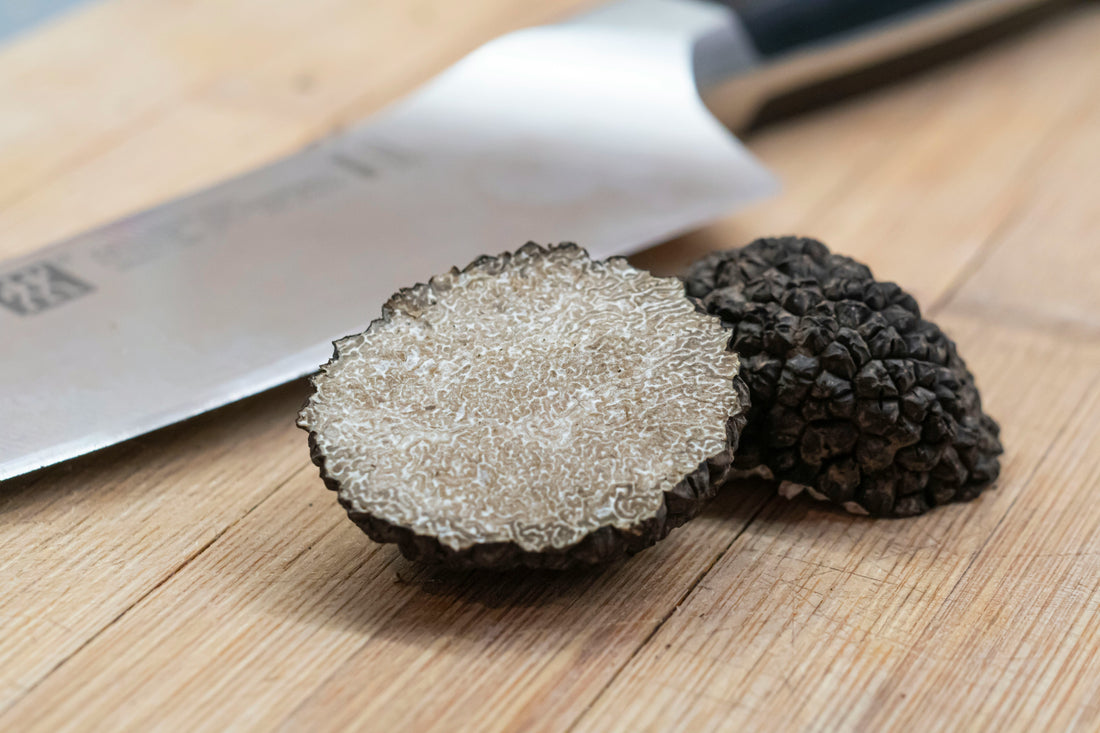
Black truffle: price, taste, differences, health & use at a glance
What is black truffle (Tuber melanosporum)?
The black truffle, scientifically known as Tuber melanosporum, is one of the most prized and sought-after truffle varieties worldwide. It is also called the Périgord truffle, named after the renowned French region famous for its production.
Black truffles grow underground in a symbiotic relationship with certain hardwood trees like oak, hazelnut, or beech. The fruiting bodies mature in winter, earning them the name winter truffles. They are typically harvested between November and March using specially trained dogs or pigs.
Externally, a black truffle appears unassuming—an irregular, dark, rough knob. Inside, however, its quality reveals itself: a black to dark-purple marbled flesh with white veins, the hallmark of a premium specimen.
With its rich, earthy, nutty, and slightly sweet aroma, the black truffle is highly esteemed in fine dining. It’s no wonder food lovers worldwide ask: “What is a black truffle and why is it so special?”
How much does 100 g of black truffle cost?
The question “How much does 100 g of black truffle cost?” is frequently asked during truffle season—and the answer depends on several factors. On average, 100 grams of fresh black truffle costs between $40 and $70 USD, though top-grade specimens from France or Italy can be more expensive.
The main price factors include:
- Origin: Truffles from France (Périgord), Italy, or Spain command higher prices.
- Harvest season: Peak season (December–February) often brings slightly lower prices due to greater supply.
- Quality: Size, freshness, aroma intensity, and visible marbling all play a role.
- Availability: Weather conditions, soil quality, and overall demand influence yearly supply and cost.
Prices can vary in grocery stores, markets, and online. When shopping, look for origin certification and freshness guarantees, since lower-quality or Chinese-market truffles may be sold as “true black truffle.”
For regular use, consider preserved products such as truffle butter, oil, or paste—they are more affordable, though less aromatic than fresh truffles.
What is the difference between white and black truffles?
Many wonder: “What's the difference between white and black truffles?” The answer lies in aroma profile, seasonality, culinary use, and price.
White truffles (Tuber magnatum) from Italy’s Alba region are the most exclusive. Found between October and December, they offer an intense garlicky aroma and are never cooked but shaved raw over dishes like pasta, risotto, or eggs.
Black truffles (Tuber melanosporum) mature slightly later, from November to March, with an earthy, nutty flavor enhanced by subtle forest, hazelnut, and cocoa aromas. Unlike white truffles, they can be lightly cooked to release their full aroma.
Price differences are significant: white truffles can fetch over $5,500 per kilogram, while black truffles remain luxury items at more accessible prices.
Summary: Both truffles offer unique gourmet experiences; choosing depends on the recipe, technique, and flavor preference.
What does black truffle taste like?
If you’ve never tried real black truffle, you might wonder: What does black truffle taste like? The flavor of Tuber melanosporum is complex and uniquely distinctive.
Typically, black truffle offers an intensely earthy, slightly sweet and nutty taste, featuring notes of forest floor, cocoa, roasted hazelnuts, and a hint of pepper. Some describe its aroma as “mystical” or “warmly spicy.”
Freshly sliced, the truffle releases a bold but never overpowering aroma that beautifully complements mild, fatty ingredients like butter, egg, cream, or cheese. The key is balance: the truffle enhances, not dominates.
Flavor intensity varies based on freshness, origin, ripeness, and cooking method. Properly used, black truffle is a sensory masterpiece—subtle, layered, and unforgettable.
Are black truffles healthy?
Black truffles are not just a luxury—they also raise the question: “Are black truffles healthy?” The answer may surprise you.
They contain multiple bioactive compounds and micronutrients with potential health benefits:
- Antioxidants: Natural polyphenols and ergothioneine help neutralize free radicals.
- Vitamins: B‑vitamins (B2, B3, B5) and small amounts of vitamin C support energy and immunity.
- Minerals: Potassium, calcium, magnesium, and iron aid circulation, bone strength, and blood health.
- Dietary fiber: Supports healthy digestion.
Black truffle has also been traditionally valued for anti-inflammatory and antimicrobial properties. Some studies even suggest mood-enhancing effects due to precursor compounds.
Of course, truffle is not a health cure, but as a premium natural ingredient it can enrich a nutritious diet with flavor and subtle wellness perks.
How do you store black truffles?
When you buy fresh truffles, the question arises: “How do you store black truffles correctly?” Their delicate aroma requires careful handling.
Fresh black truffles are perishable and should be consumed within 7 to 10 days. Best storage methods include:
- Refrigerator: Wrap in paper towel, store airtight in a jar, and change the towel daily.
- In rice: Place truffles in uncooked rice to absorb moisture and help preserve aroma.
- Terracotta jar: A traditional cool, dry, and dark storage method for short-term use.
Avoid: moist or sealed environments, as they promote mold. Freezing damages texture and aroma. For longer storage, pickling, freezing, or drying are options, though some flavor is lost. Ideally: use fresh and enjoy promptly.
How should you use black truffles in cooking?
Black truffle is a culinary treasure—but the question remains: “How should you use black truffles in cooking?” Only the right method brings out its full aromatic potential.
Unlike delicate white truffles, black truffle may be lightly cooked. Gentle heat unlocks its full aroma. Key is avoiding high temperatures that can diminish its fragrance.
Popular uses include:
- Pasta: Tagliolini or tagliatelle with truffle butter or cream sauce, topped with shaved truffle
- Risotto: Creamy risotto stirred or garnished with grated truffle
- Egg dishes: Scrambled eggs, omelets, or poached eggs flavored or garnished with truffle
- Truffle butter & oil: Homemade or store-bought, perfect for enhancing simple dishes with gourmet flair
- Meat & fish: As a finishing touch over filet, carpaccio, or sautéed fish—use sparingly
Tip: Use a truffle slicer to shave thin slices or finely grate, then add just before serving to preserve aroma.
Just a few grams can transform everyday dishes into luxurious culinary masterpieces.
How to identify high-quality black truffles and where to buy them?
The final key question: “How to identify high-quality black truffles and where should I buy them?” Because luxury demands scrutiny.
A premium black truffle shows these traits:
- Strong aroma: Earthy and nutty—never musty or off-smelling
- Firm texture: The truffle should resist gentle pressure and not be soft
- Characteristic marbling: Fine white veins within the dark flesh
- Clear origin: Preferably France (Périgord), Italy (Umbria, Tuscany), or Spain
Warning: Cheap imitations—such as “Chinese truffle” (Tuber indicum)—look similar but offer little aroma and culinary value. Reliable sellers list species and origin clearly.
You can find real black truffle at:
- Specialized online shops with freshness guarantees
- Gourmet food stores or upscale markets
- Directly from truffle hunters or producers
Look for transparency in listings—details on species, origin, storage, and shipping temperature. Some vendors offer small sample sizes (from 0.5 oz/15 g), perfect for first-timers.
